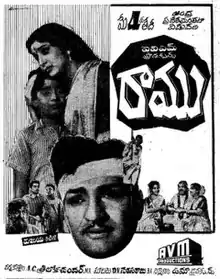| Ramu | |
|---|---|
 Theatrical release poster | |
| Directed by | A. C. Tirulokchandar |
| Written by | D. V. Narasa Raju (dialogues) |
| Screenplay by | Javar Seetharaman |
| Story by | Kishore Kumar |
| Based on | Door Gagan Ki Chhaon Mein (1964) |
| Produced by | M. Murugan M. Kumaran M. Saravanan M. Balasubramanian M. S. Guhan |
| Starring | N. T. Rama Rao Jamuna |
| Cinematography | D. Rajagopal |
| Edited by | R. G. Gopu |
| Music by | R. Govardhanam |
Production company | |
Release date |
|
Running time | 172 minutes |
| Country | India |
| Language | Telugu |
Ramu is a 1968 Indian Telugu-language drama film produced by AVM Productions and directed by A. C. Tirulokchandar. The film stars N. T. Rama Rao and Jamuna with Master Rajkumar in the title role reprising his role from the Tamil film. The film's music was composed by R. Govardhanam. It is a remake of the Hindi film Door Gagan Ki Chhaon Mein (1964), which was first remade as the Tamil film of the same name (1966). The film was a silver jubilee hit.[1]
Plot
Ramu is an active boy who lives happily with his father, Raja, and mother, Seeta. One day, Raja, who works as a soldier, receives an emergency call and rushes to the battlefield. While he is gone, dacoits attack their village and set fire to Ramu's house, burning Seeta alive. The sight causes Ramu to lose his voice. Afterwards, their neighbour Chinnayya takes care of Ramu and waits for Raja's arrival. Raja returns and goes into shock, knowing the facts, takes an oath to get back his son's voice, and they leave the village.
Parallelly, in another village, Lakshmi, daughter of Sipayi Singanna, is a wealthy woman whose property is under the guardianship of her maternal uncle Ganganna. Ganganna has two sons: Ranganna, as crooked as his father, and Venkanna, a kind-hearted person. Ganganna wants to grab Lakshmi's property by performing her marriage with Ranganna. But Lakshmi gets back her property through the court. Due to this, Ganganna develops a grudge against her.
On their way back, Ramu and Raja pass through the village where Ranganna beats Ramu for obstructing when the quarrel arises between Raja and Ranganna. Ranganna back-stabs Raja, and he faints. Lakshmi spots them, takes them along with her, and requests Raja to stay in her house until he recovers. Days pass, and Ramu gets closer to Lakshmi; she also cares for him as her son and loves Raja.
Meanwhile, Ganganna does no one work in Lakshmi's fields when Raja comes forward and completes the farming. Eventually, Ramu visits a burial ground where he meets a madman, Gopalam, whose daughter has been cheated on by Ganganna. Both Gopalam and Ramu become good friends. Frustrated, Ranganna kidnaps Ramu and keeps him in his custody. Lakshmi, in search of Ramu, reaches there when Ranganna tries to molest her. Venkanna informs Raja, and he, too, lands. In that quarrel, fire erupts, and Lakshmi is stuck in it. Due to this incident, Ramu gets back his voice and saves her. Gopalam recognizes Ganganna, kills him, and gets arrested. The film ends with the marriage of Raja and Lakshmi.
Cast
- N. T. Rama Rao as Raja
- Jamuna as Lakshmi
- S. V. Ranga Rao as Gopalam
- V. Nagayya as Swamiji
- Relangi as Ganganna
- Ramana Reddy as Armugam
- Rajanala as Ranganna
- Satyanarayana as Puli
- Padmanabham as Venkanna
- Allu Ramalingaiah as Lawyer
- Master Rajkumar as Ramu
- S. V. Ramadas as Sipayi Singanna
- Perumallu as Chinnayya
- Suryakantham as Manikyam
- Geetanjali as Ratnam
- Pushpalatha as Seeta
Music
Music was composed by R. Govardhanam.[2]
| Song Title | Lyrics | Singers | length |
|---|---|---|---|
| "Pacchani Chettu" | Aarudhra | P. Susheela | 3:01 |
| "Thaaraa Shashaankam" | Kosaraju | Pithapuram, Madhavapeddi Satyam L. R. Eswari, R. Tilakam | 7:41 |
| "Pacchani Chettu" – 2 | Aarudhra | Ghantasala, P. Susheela | 3:40 |
| "Kalaganti Kalaganti" | Dasaradhi | Ghantasala, P. Susheela | 5:00 |
| "Maamidi Komma" | Dasaradhi | P. Susheela | 3:31 |
| "Raaraa Krishnayya" | Dasaradhi | Ghantasala | 5:37 |
Release and reception
Ramu was released on 4 May 1968.[3] The film had a 100-day run 15 centers. running for 181 days at Durga Kala Mandir, Vijayawada, and becoming a silver jubilee hit.[4]
References
- ↑ Narasimham, M. L. (5 April 2019). "Ramu (1968)". The Hindu. Archived from the original on 1 February 2020. Retrieved 7 April 2019.
- ↑ "Ramu (1968)-Song_Booklet". Indiancine.ma. Archived from the original on 21 November 2022. Retrieved 2 November 2022.
- ↑ Saravanan 2013, p. 203.
- ↑ "Cinema Halls – Durga Kala Mandir, Vijayawada". Idlebrain.com. Archived from the original on 22 June 2017. Retrieved 4 September 2017.
Bibliography
- Saravanan, M. (2013) [2005]. AVM 60 Cinema (in Tamil) (3rd ed.). Rajarajan Pathippagam. OCLC 1158347612.